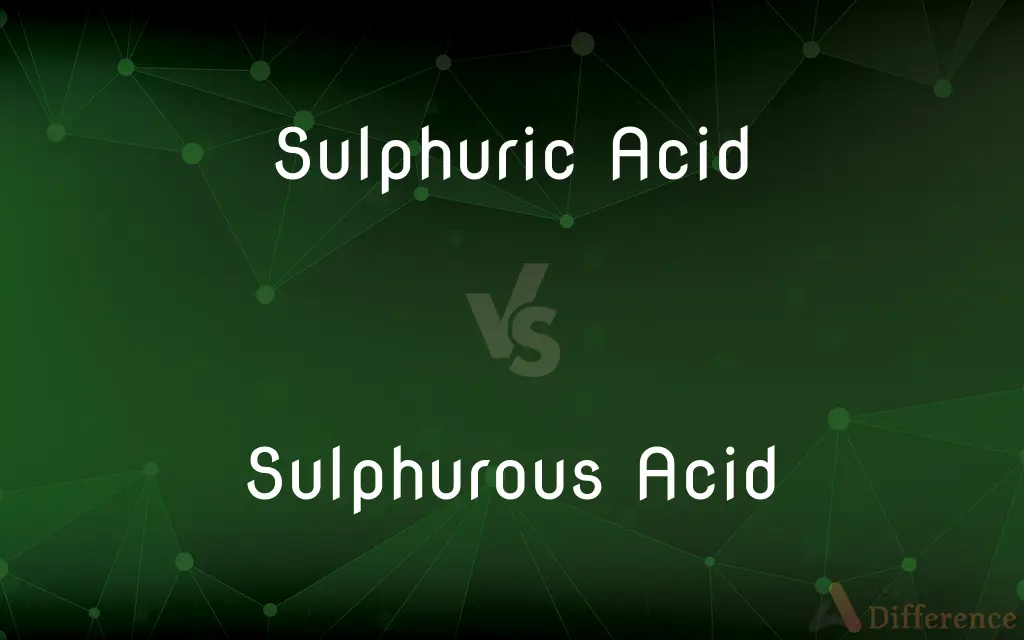Sulphuric Acid vs. Sulphurous Acid — What's the Difference?
By Fiza Rafique & Maham Liaqat — Published on February 24, 2024
Sulfuric acid (H2SO4) is a strong, highly corrosive mineral acid used widely in industrial processes, while sulfurous acid (H2SO3) is a weak, unstable acid, primarily existing in aqueous solutions and significant in environmental processes like acid rain.

Difference Between Sulphuric Acid and Sulphurous Acid
Table of Contents
ADVERTISEMENT
Key Differences
Sulfuric acid, with its formula H2SO4, is known for its high acidity and oxidative properties, making it one of the most important acids in the chemical industry. It's used in the production of fertilizers, in petroleum refining, and as a cleaning agent in various sectors. Its strong dehydrating nature allows it to remove water from substances, making it effective in manufacturing processes that require dehydration reactions.
Sulfurous acid, H2SO3, in contrast, is less stable and is not commonly found in its pure form. It is typically generated in aqueous solutions through the dissolution of sulfur dioxide (SO2) in water, playing a crucial role in the formation of acid rain. Sulfurous acid is a much weaker acid compared to sulfuric acid and is used primarily as a reducing agent and a disinfectant in various applications. Its weak nature makes it less corrosive and safer to handle under controlled conditions.
The oxidation state of sulfur in sulfuric acid is +6, which is higher than the +4 oxidation state of sulfur in sulfurous acid. This difference in oxidation states reflects the stronger oxidative capacity of sulfuric acid, making it a more potent oxidizing agent. Sulfuric acid's ability to donate two protons (H+ ions) in reactions categorizes it as a strong diprotic acid, whereas sulfurous acid, also diprotic, does not fully dissociate in water, highlighting its weak acid status.
Environmental impacts of both acids are significant but in different ways. Sulfuric acid is a key component in industrial emissions that contribute to acid rain, albeit indirectly through the oxidation of sulfurous acid. Sulfurous acid's direct formation from sulfur dioxide and water in the atmosphere makes it immediately relevant to environmental concerns related to air quality and acid precipitation.
In terms of applications, sulfuric acid's role is predominantly industrial, driving numerous chemical synthesis processes and manufacturing operations. Sulfurous acid finds use in preserving food and brewing due to its antimicrobial properties, and in water treatment, where it helps remove residual chlorine and oxidize pollutants without the potent corrosive effects of sulfuric acid.
ADVERTISEMENT
Comparison Chart
Acidity
Strong acid
Weak acid
Stability
Highly stable
Unstable, exists mainly in solution
Oxidation State
+6
+4
Industrial Use
Fertilizers, petroleum refining, cleaning
Disinfectant, food preservation
Environmental Impact
Contributes to acid rain indirectly
Directly forms acid rain
Oxidizing Property
Strong oxidizing agent
Used as a reducing agent
Corrosivity
Highly corrosive
Less corrosive
Applications
Broad industrial applications
Limited to specific niches like food and brewing
Compare with Definitions
Sulphuric Acid
A strong mineral acid used in fertilizer production.
Sulfuric acid is essential for manufacturing phosphate fertilizers.
Sulphurous Acid
Formed by dissolving sulfur dioxide in water.
Sulfurous acid is created when SO2 from volcanic gases dissolves in rainwater.
Sulphuric Acid
Serves as an electrolyte in lead-acid batteries.
Sulfuric acid's conductivity makes it suitable for car batteries.
Sulphurous Acid
Used in food preservation for its antimicrobial properties.
Sulfurous acid solutions are used to sanitize wine barrels.
Sulphuric Acid
Contributes to environmental concerns indirectly.
Industrial emissions of SO2 can lead to sulfuric acid formation in the atmosphere.
Sulphurous Acid
Less stable and exists mainly in aqueous solutions.
Sulfurous acid breaks down easily, limiting its storage as a pure substance.
Sulphuric Acid
Highly corrosive, capable of dehydrating substances.
Sulfuric acid can char organic compounds by removing water.
Sulphurous Acid
Directly associated with acid rain formation.
Emissions from burning fossil fuels increase sulfurous acid in the atmosphere.
Sulphuric Acid
Used in oil refining and chemical synthesis.
Sulfuric acid catalyzes the alkylation process in petroleum refining.
Sulphurous Acid
Acts as a weak acid and reducing agent.
Sulfurous acid can reduce certain dyes, making it useful in paper manufacturing.
Common Curiosities
Why is sulfuric acid more widely used industrially than sulfurous acid?
Its stability, strong acidity, and dehydrating properties make sulfuric acid more versatile and valuable in a wide range of industrial processes.
What environmental issues are associated with sulfuric and sulfurous acids?
Both contribute to acid rain, with sulfuric acid forming through the oxidation of sulfurous acid, leading to environmental degradation and impacting water and soil quality.
Can sulfuric and sulfurous acids be neutralized? If so, how?
Yes, both acids can be neutralized by alkaline substances. Lime (calcium hydroxide) is commonly used to neutralize acidic wastewater containing these acids, converting them into less harmful sulfate salts.
Can sulfurous acid exist in a pure form?
Sulfurous acid is unstable and predominantly exists in aqueous solutions rather than in a pure form.
How do the oxidation states of sulfur in sulfuric and sulfurous acids affect their properties?
The higher oxidation state of sulfur in sulfuric acid makes it a stronger oxidizing agent and acid compared to sulfurous acid, affecting their reactivity and applications.
Are there safety concerns in handling sulfuric acid compared to sulfurous acid?
Yes, sulfuric acid's corrosive nature requires stricter safety measures to prevent chemical burns and damage to materials, whereas sulfurous acid, being weaker, poses less risk.
What role do sulfuric and sulfurous acids play in the water cycle?
They contribute to acid rain, which can lower the pH of water bodies and soil, affecting aquatic life and plant growth. Sulfurous acid, being more volatile, can be more readily converted to sulfuric acid in the atmosphere, further contributing to acid rain.
How are sulfuric and sulfurous acids detected in environmental samples?
Detection often involves chemical analysis techniques such as titration for acidity levels, ion chromatography, or spectrophotometry to identify and quantify their presence in water and air samples.
How does the presence of sulfuric and sulfurous acids in the atmosphere affect human health?
Both acids, when present in the atmosphere, can contribute to respiratory problems and irritation of the skin and eyes. Sulfuric acid, due to its corrosive nature, poses a greater risk for deep respiratory tract issues when inhaled as part of fine particulate matter.
Are there any biological uses or impacts of sulfuric and sulfurous acids?
While direct biological roles are limited due to their corrosive nature, the acids' impact on ecosystems through acid rain can indirectly affect plant nutrient availability and aquatic habitats.
How does the use of sulfuric acid in industrial processes contribute to its environmental impact?
Its use in large quantities, especially in mining and manufacturing, can lead to accidental spills and emissions that contribute to water and soil pollution, necessitating careful handling and disposal practices.
What measures can be taken to reduce the environmental impact of sulfuric and sulfurous acids?
Reducing sulfur dioxide emissions through cleaner energy sources, flue-gas desulfurization, and industrial scrubbers can lessen the formation of these acids in the atmosphere, mitigating their environmental impact.
What are the differences in storage requirements for sulfuric and sulfurous acids?
Sulfuric acid requires storage in corrosion-resistant containers due to its highly corrosive nature and stability, while sulfurous acid, being less stable and commonly existing in solution, requires containers that can prevent its decomposition or release into the environment.
What are the primary industrial sources of sulfur dioxide that lead to sulfurous acid formation?
The burning of fossil fuels by power plants, industrial facilities, and vehicles is the primary source of sulfur dioxide emissions, which then dissolve in atmospheric moisture to form sulfurous acid.
How do sulfuric and sulfurous acids affect building materials and monuments?
Acid rain containing these acids can corrode metal structures and erode buildings, statues, and monuments made from limestone and marble, causing significant cultural and economic damage.
Share Your Discovery

Previous Comparison
Fish Sauce vs. Oyster Sauce
Next Comparison
Ritalin vs. DexamphetamineAuthor Spotlight
Written by
Fiza RafiqueFiza Rafique is a skilled content writer at AskDifference.com, where she meticulously refines and enhances written pieces. Drawing from her vast editorial expertise, Fiza ensures clarity, accuracy, and precision in every article. Passionate about language, she continually seeks to elevate the quality of content for readers worldwide.
Co-written by
Maham Liaqat















































